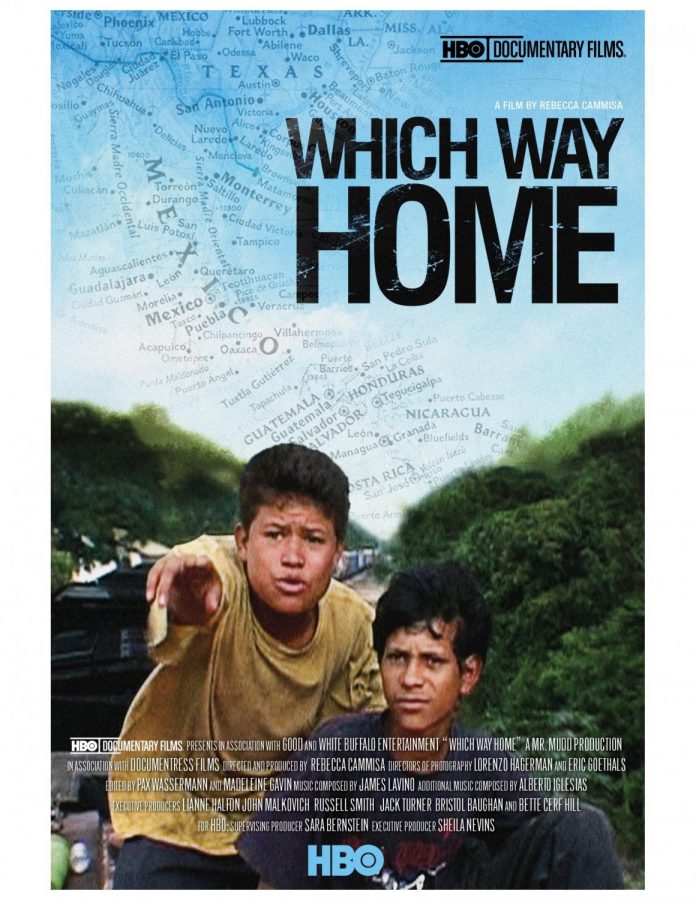Documentary highlights U.S. immigration issues
Courtesy of Mr. Mudd/Documentress Films
Film poster for Which Way Home directed by Rebecca Cammisa.
October 13, 2018
The documentary Which Way Home presents the journey of unaccompanied children as they avoid death by trains, starvation, rape, muggings, police brutality and deportation to immigrate to the U.S..
After viewing the 2009 feature documentary directed by Rebecca Cammisa, the CHABBS Global Commitment Committee offered discussion between a panel of CSUSM professors and attendees.
This semester, the Global Commitment Committee is focused on the broad topic of children and Which Way Home, was screened Oct. 2.
The film opened with an unidentified Mexican police officer speaking about an incident in which American officials retrieved a child’s body that had floated to the U.S. side of the Rio Grande river.
“Does this happen frequently?” asked a film crew member. “Yes, frequently with people trying to get to the United States, unfortunately,” the officer said.
Which Way Home explored many deaths of migrating children, like two cousins Eloy and Rosario who died crossing the desert.
The reasons for migrating varied child to child from escaping abusive parents and extreme poverty to achieving goals and dreams.
The film features a pair of unaccompanied children, 14-year-old Kevin and 13-year-old Fito, leave Honduras for U.S. Along the way, they meet 14-year-old Jairo and 17-year-old Yurico from Mexico and travel north with them.
In the end, only Kevin reaches the U.S. and is taken to a California detention center while Fito is deported back to Honduras and Yurico and Jairo to Mexico.
Throughout the film, nine-year-olds Olga and Freddy lost connection with the film crew. Jose, a 10-year-old Salvadoran, and others who were abandoned by smugglers and taken to a deportation center, were given short segments showcasing their struggles and story.
After the film, the discussion panelists Dr. Antonio De La Garza (Communication), Dr. Cynthia Melendrez (Modern Language Studies) and Dr. Bonnie Bade (Anthropology) analyzed the film’s meaning.
Dr. De La Garza spoke about how U.S. citizens play a role in immigration violence.
“… The narrative that it shows is just how dangerous the passage from anywhere in Mexico to the United States is … those people, those children [still] are willing to risk everything; risk being assaulted, losing their homes, their lives, for what we have,” said Dr. De La Garza.“… [W]e need to realize that we are [all] complicit with that violence.”
He discussed how the representations U.S. citizens send out to the world is “like DisneyLand and the City of Gold combined”, an image of opportunity and prosperity but what they physically send out is corruption and greed.
What he doesn’t like about this film is that “it personalizes these experiences…it ignores the ways U.S. colonialism and imperialism have created the poverty these children are running from…it doesn’t place the blame where blame belongs (the structures of the United States).”
Dr. Bade discussed wage labor in Central America and Mexico, where laborers cannot afford to live on their limited income.
“Transnational migration is a means of survival for [thousands] of people and when you hear politics talking about [illegally crossing the border], it’s much more complicated than that,” Dr. Bade said.
She said immigrants’ labor helps “make California the sixth richest entity in the world … because of agriculture.”
Dr. Melendrez talked about film’s limitations.
“They only mention poverty … they never talk about guns,” she said. The conflicts in the border in the south of Mexico, the violence in Honduras, the lack of education contribute to the suffering.
“They don’t even talk about the numbers … what happened to the rest of them” — the 40,000 missing children” referred to in the film, she said.
She said that they are humanizing the issue by not showing the problems immigrants live with and that the film is “an eye-opener for us to start thinking, what are we going to do when we see something like this?”. Dr. Melendrez mentioned how human and organ trafficking didn’t appear, how Rebecca Cammisa’s lacks credibility and how Cammisa only showed superfluous things about the situation.
She said that the film is severely lacking mainly because of U.S. citizens, “this film is a lack of reality, that we don’t talk about it (the issues) because we are uncomfortable.”
The GCC will host a screening and discussion of the movie “the Dark Side of Chocolate” on Nov. 5 in the USU Ballroom, 5:30 p.m. to 8:00 p.m.






